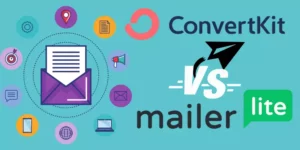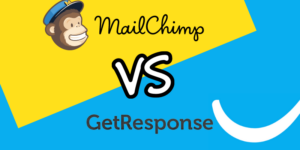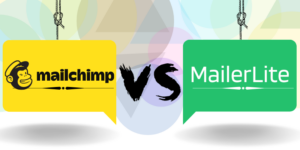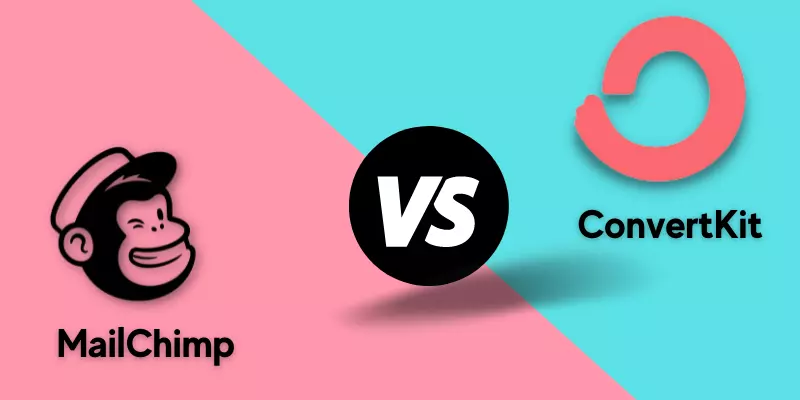
ConvertKit or Mailchimp? Choosing among these two is a big decision. Because both of them are comparatively different email marketing tools and also both are great email marketing tools with a lot of great features. ConvertKit is more based on Content marketers, bloggers, and single business owners. And MailChimp is for Large corporate businesses. I have tested both of the tools and below is the comparison between ConvertKit Vs Mailchimp. By the end of this comparison, you can decide which one is the right option for you.
Quick Summary
ConvertKit
- Built-in lead capture pages
- More versatile forms
- High deliverability rate
- Built-in email Sequences
- Text-based Emails
- Free version Available Forever
- Good for content Marketers, Bloggers, & Single Business owners.
MailChimp
- Good number of Templates
- Website builder available
- Affordable
- Social Media posting
- More integration.
- Have Mobile app
- Free version available
- Best for large business organizations & beginners
What is ConvertKit?
ConvertKit is one of the fastest-growing email marketing companies in the world. It’s easy to use, its visual automation workflow is great, and so many other features make ConvertKit unique. They are providing customizable landing pages and sign-up forms.
Who uses: Single business owners, Bloggers, Content marketers
What is Mailchimp?
Mailchimp is a general email marketing tool. Since Mailchimp’s free plan is popular and beginner-friendly. Mailchimp has so many features. But most of them are extremely priced and are suitable for large-scale corporate businesses. The highest number of users are beginners who are just started to learn. That’s why Mailchimp contributes the highest number of spam emails.
Who uses: Large corporate businesses, Small businesses, Universities, Local clubs, etc
Why you should use ConvertKit over MailChimp?
Here’s what’s great about ConvertKit:
- They have Built-in lead capture pages: ConvertKit has customizable and attractive landing pages for capturing leads. You can save some money by not having Lead Pageservices like Unbounce, Leadpages, Instapage, etc.
- More versatile forms: ConvertKit has more options in its form builder than Mailchimp does.
- Free Migration: You can easily migrate from your previous email marketing provider to ConvertKit without losing any data.
- It has an easy-to-use editor for simple emails. ConvertKit makes it very easy to compose plain emails or text-based emails.
- They have an interface for adding and uploading images.
Why you should use MailChimp over ConvertKit?
Here’s what’s great about Mailchimp:
- Email builder is simple and easy to use.
- MailChimp support 250+ integrations. On the other hand, ConvertKit supports less than 100 integrations.
- You will get a free Mailchimp domain for all plans.
- Built-in Analytics: Mailchimp provides you with built-in analytics that offers you a real-time analysis of your campaign performance.
- Marketing CRM: Mailchimp provides you with marketing CRM, there you will get a detailed review of your customer.
- The mobile app is available.
Difference Between ConvertKit & MailChimp
- ConvertKit focus on subscribers whereas MailChimp focuses on the subscriber list.
- ConvertKit is more affordable than Mailchimp. Because Mailchimp will count on duplicate subscribers. But ConvertKit does not count on duplicate subscribers.
- Mailchimp charges you for unsubscribers in the list. ConvertKit does not.
- MailChimp has a drag and drop feature that ConvertKit doesn’t have.
- Mailchimp is best for large corporate businesses and small businesses. ConverKit is best for Bloggers and content creators
Some of the common features & their rating are given below.
| Email Marketing Features | ConvertKit | MailChimp |
|---|---|---|
| Ease of use | Easy to use. Best for beginners. | Pretty straightforward. Will take time to understand all features at first. |
| A/B Split Testing | Split test for the subject line. | Split test for the Subject line, Content, and Form name. |
| Apps & Integration | More integrations | |
| Automation | ||
| Analytics & Report | Basic analytics & reporting | Built-in Analytics & advanced reporting |
| List Management & Segmentation | Best list segmentation & tagging feature. You can easily target your audience. | You can use tags inside the list only. |
| Deliverability | 100% deliverability rate | 71% deliverability rate |
| Email Builder | Limited customization option | Drag and drop email editor with a lot of customization features. |
| Templates & Designs | Lack of templates | Plenty of templates. But most of them are outdated and non-usable. |
| Customer support | ||
| Value for money |
FAQs
In-depth Review
1. Pros & Cons
>> ConvertKit
| Pros | Cons |
|---|---|
| Easy to use | No app |
| Plain Text style for emails | Limited option for template design |
| Ease of Tagging | No chance of Visual in the email builder |
| Great visual automation workflow. |
>> Mailchimp
| Pros | Cons |
|---|---|
| Ease of Use | Bills based on list subscribers |
| Free version available | Default templates are not good |
| So many integrations | No automation for the free version |
| A vast number of templates | |
| Drag and drop functionality is available |
2. Customer Geography
>> ConvertKit
ConvertKit is getting around 55% traffic from USA and Canada. And it is using 90% organic keywords and only 10% paid keywords. The audience geography of ConvertKit is given below.
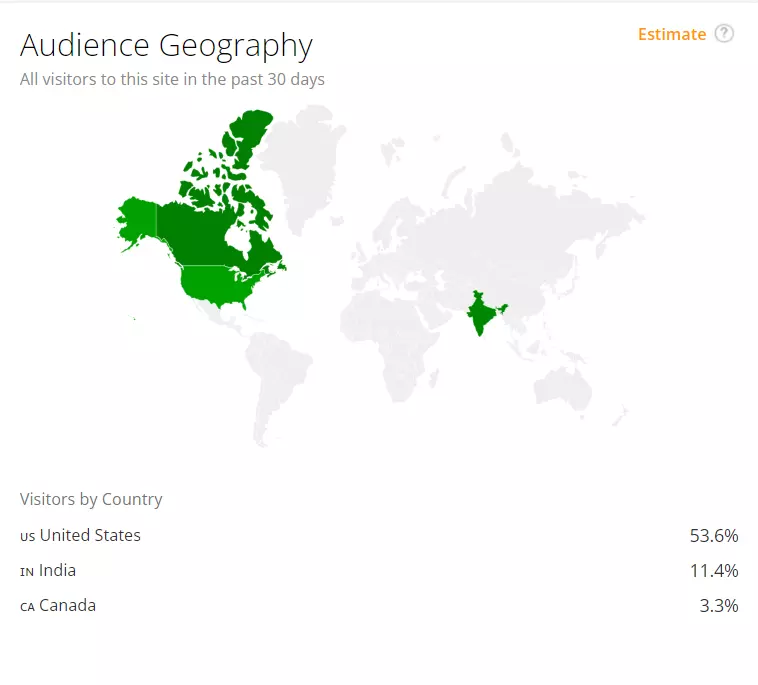
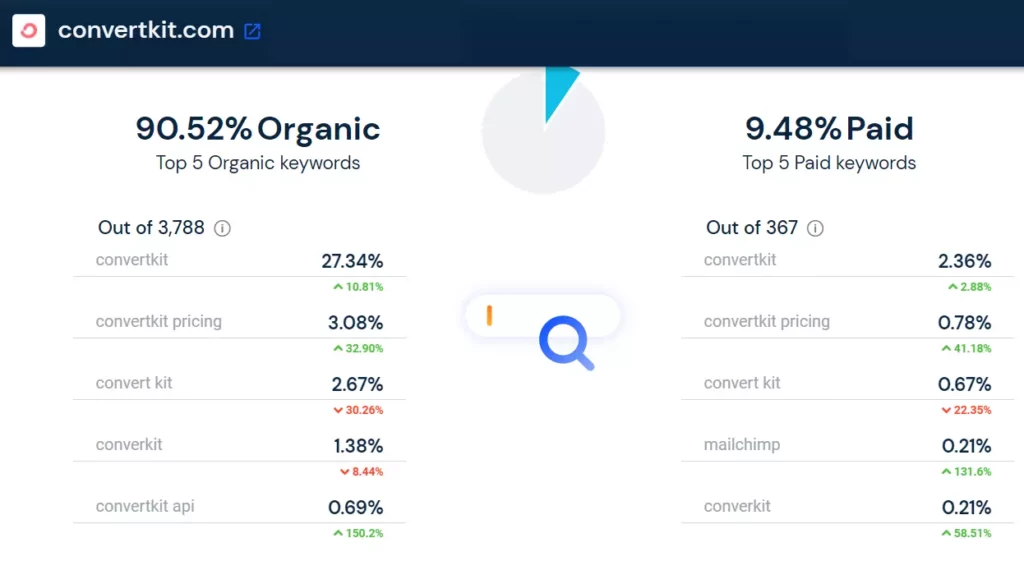
>> Mailchimp
Mailchimp is getting around 50% traffic from USA and Canada. MailChimp uses around 80% organic keywords and around 20% paid keywords. The audience geography of MailChimp is given below.
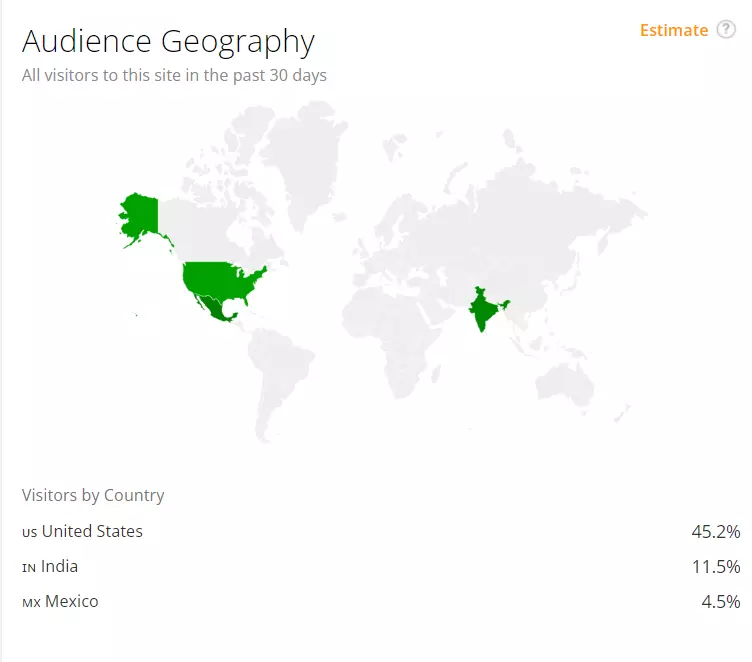
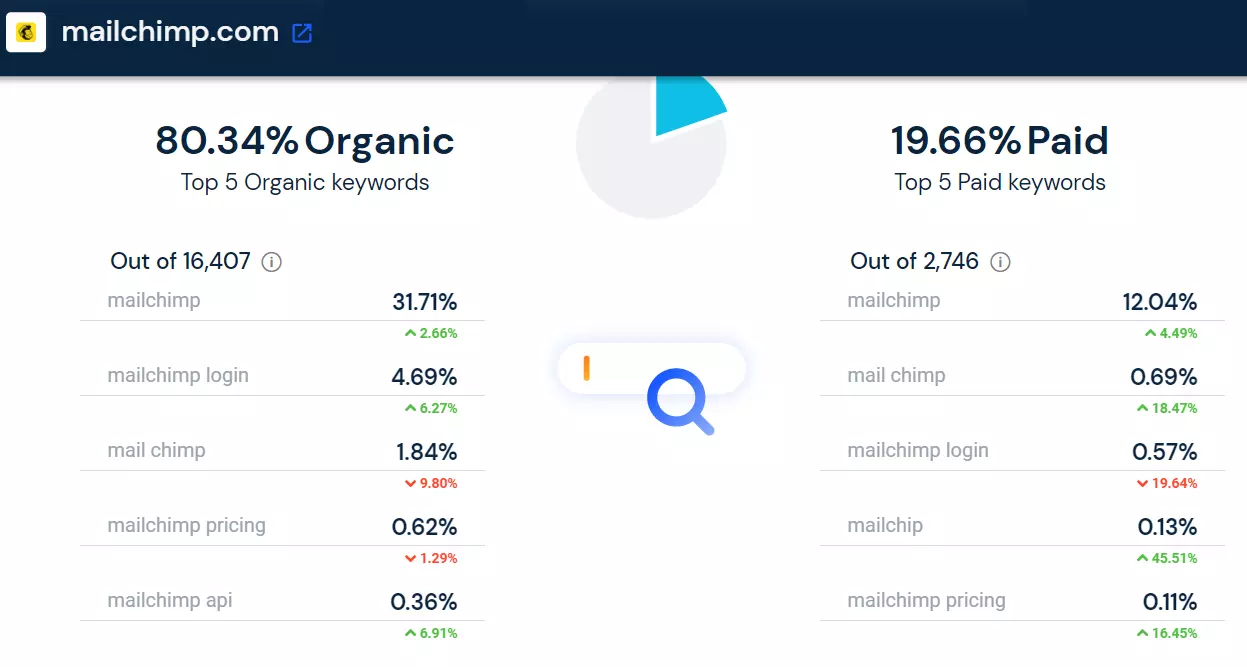
Market Share
Current Customers
3. Contact Management
>> ConvertKit
ConvertKit allows you to add only one subscriber’s list. But you can organize the subscribers by segments and tag. You can give tags to the subscribers based on your interest. And also you can create segments of contacts with similar characteristics. If you import more contacts, they all will go to the same previous list. You can add subscribers in the ConvertKit using 3 ways. You can simply add the subscribers manually, you can import CSV files or you can import the contacts from another provider like Mailchimp, Mailerlite, etc. You can also create segments and give tags to the contacts. List management in ConvertKit is given below.
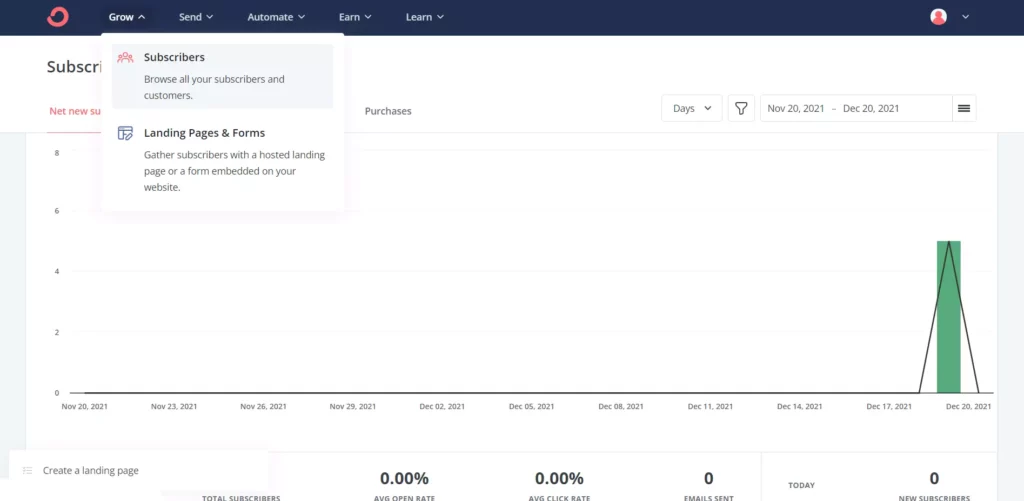
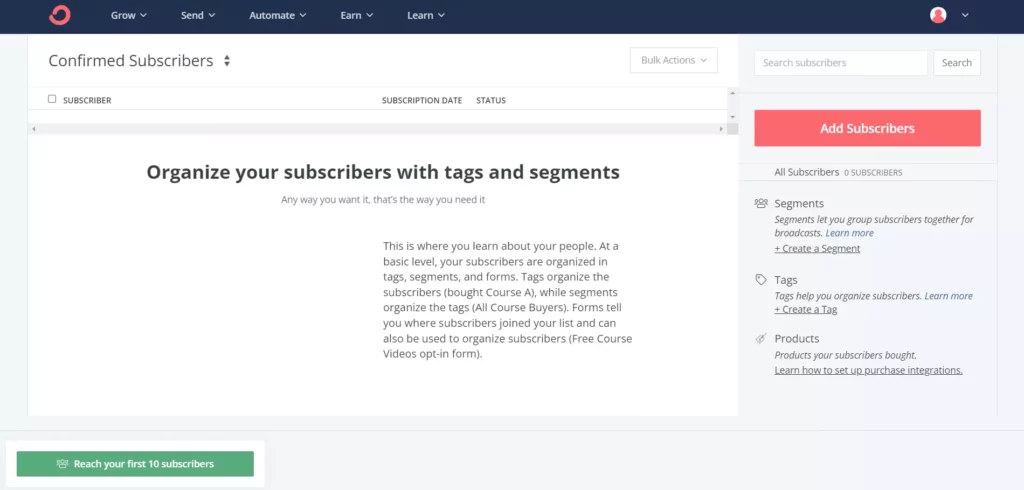
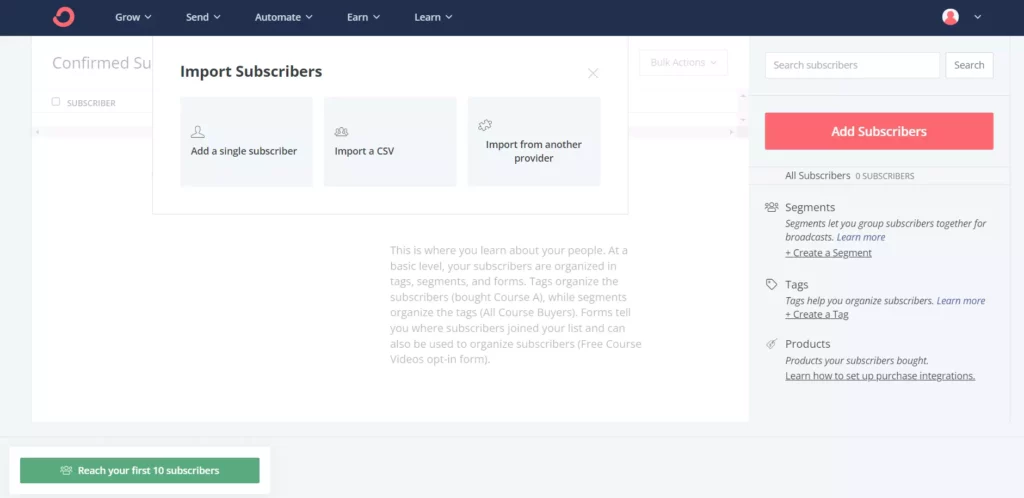
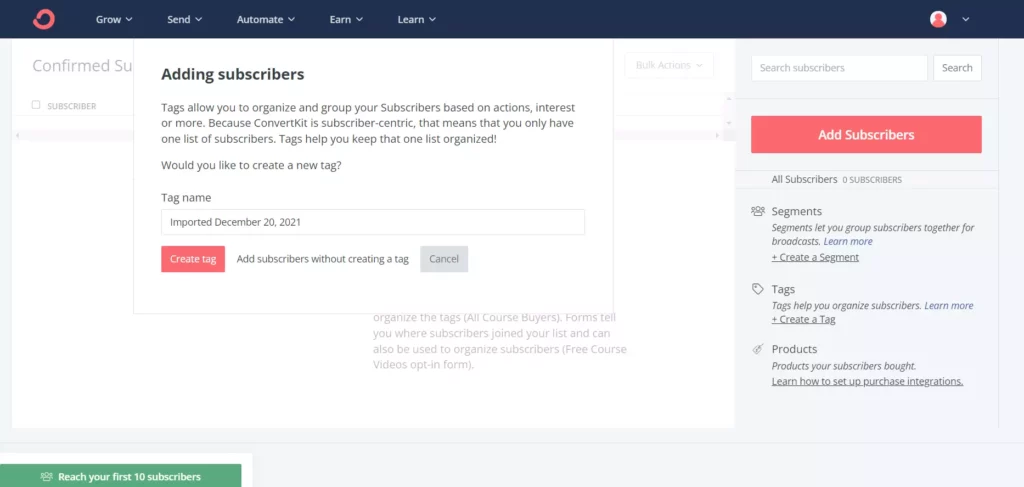
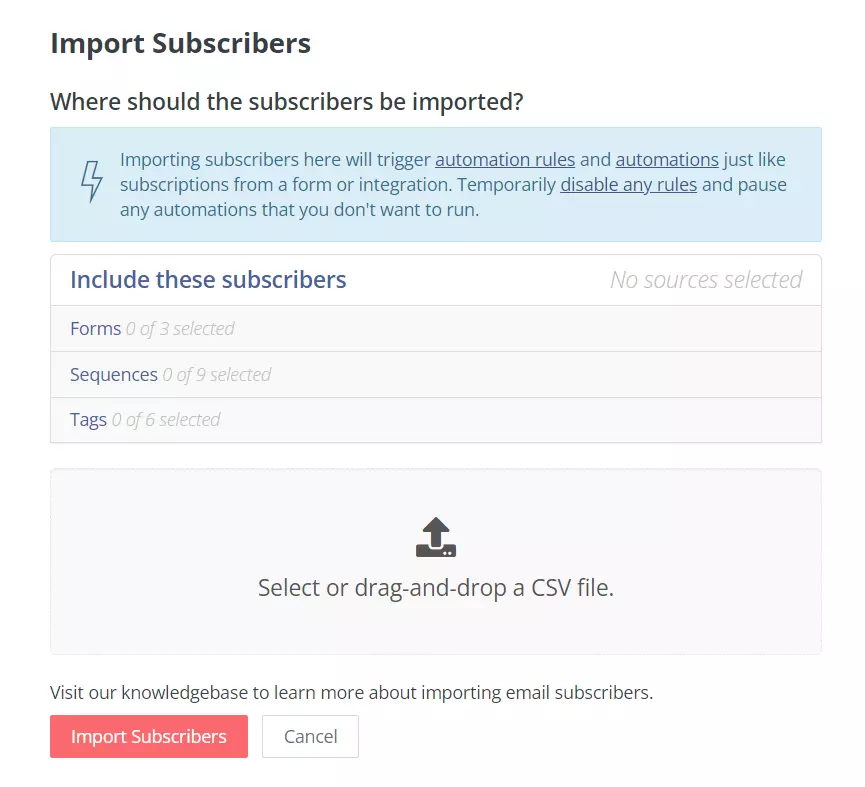
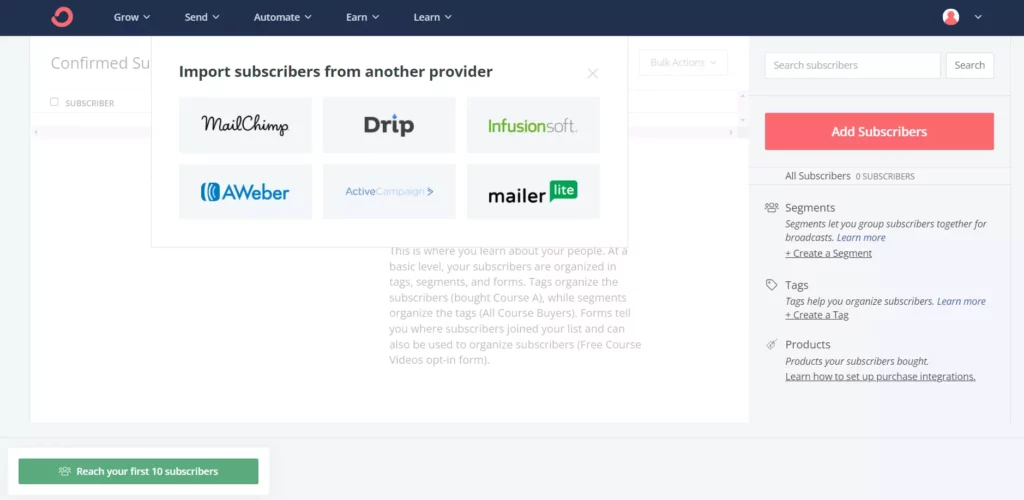
>> Mailchimp
MailChimp on the other hand allows you to create multiple lists. You can separate one contact list from one another and you can use these multiple contacts for different purposes. You can also create segments to these contact lists. You can create simple or complex segments. You can create a mailing list in Mailchimp using several ways. You can add subscribers manually, you can upload a CSV file or TXT file, and you can copy and paste the contacts from the Spreadsheet. List management in MailChimp is given below.
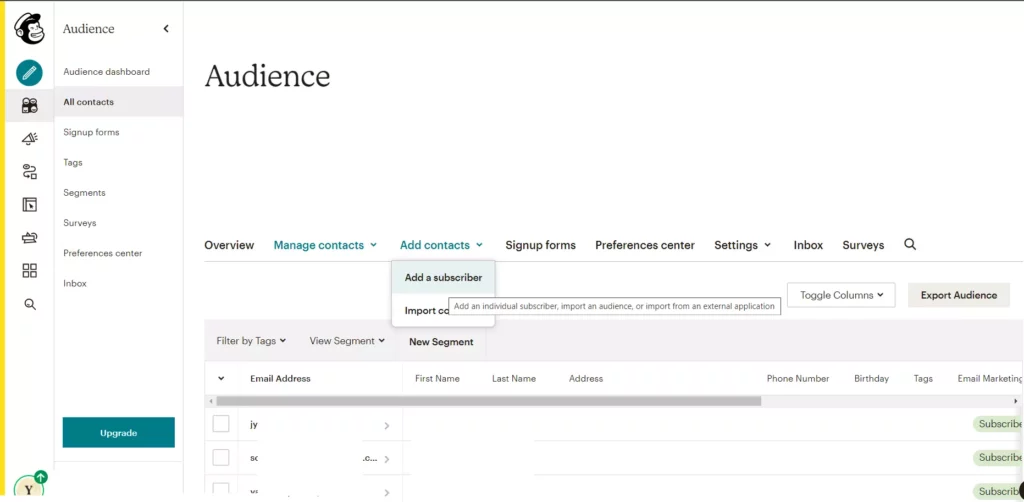
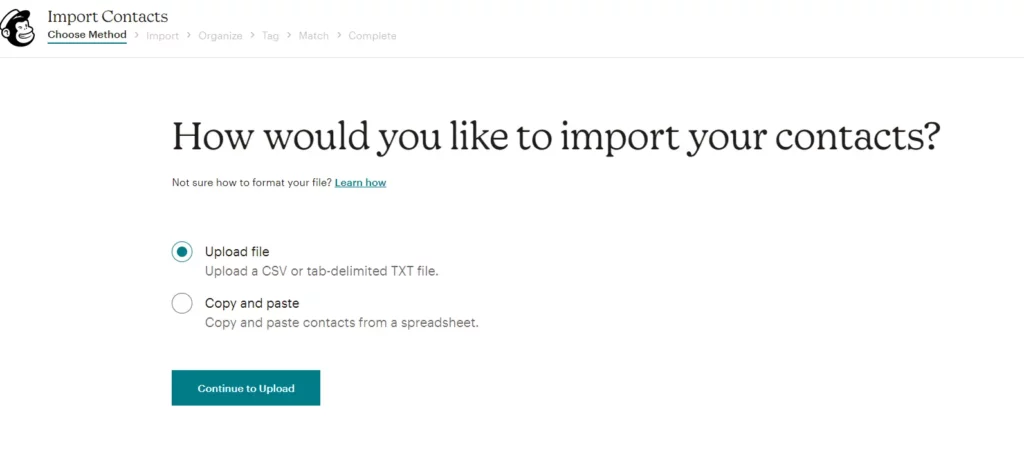
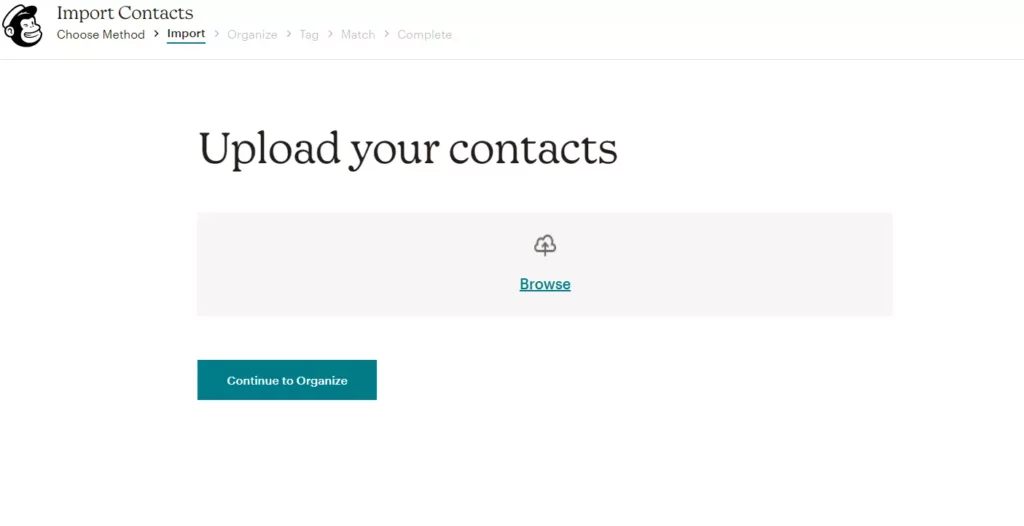
Key Take-Aways: ConvertKit allows you to create only one contact list. Even though, it allows you to create more than one segment. And also you can import subscribers from other service providers also. MailChimp allows you to create multiple contact lists. But pricing depends on the number of subscribers. If you include the same subscriber in a different list, it will count as 2 persons. That is not fair.
Winner of Contact Management: ConvertKit
ConvertKit : 1 – 0 : MailChimp
4. Templates & Design
In the area of Templates, ConvertKit and Mailchimp will differ in various ways. Both are different types.
>> ConvertKit
ConvertKit is mainly focused on text-only emails. There are mainly 3 options for templates in ConvertKit. They are Classic, Modern, and Text only. Among these, text-only is only focusing on the text. So there are only 2 templates. We can only change the appearance of the font by changing font style, font color, etc. and we can add images and links also. If you are an expert, you can code your own email templates using an HTML editor. ConvertKit is not a design-centric email marketing tool. But the studies are saying that the deliverability of the emails is high for non-design-centric emails. A text-based email will most likely end up in the inbox and not in the Spam folder.
ConvertKit Templates
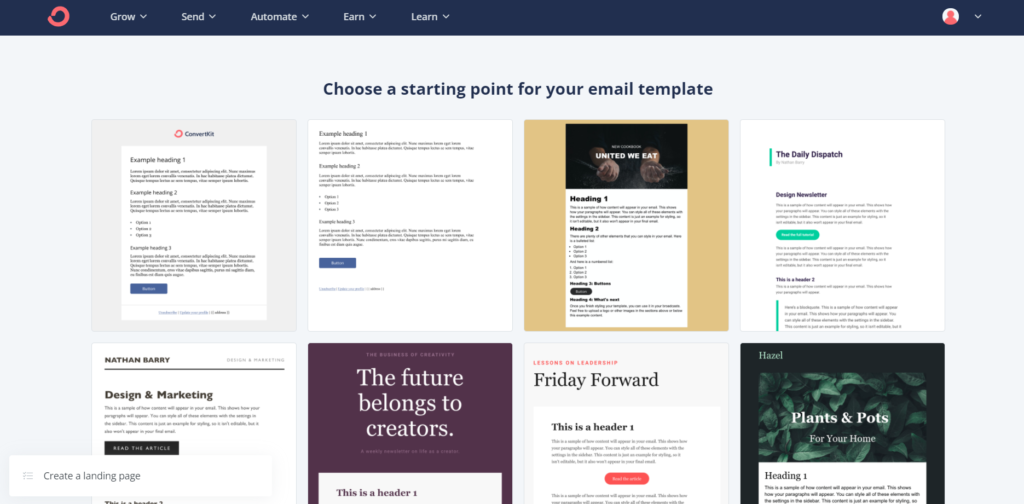
>> Mailchimp
On the other hand, MailChimp is a design-centric email marketing tool. Mailchimp provides around 100 templates with various designs. We can use them for holiday mails, newsletters, promotions, etc. Also, we can create our templates. For that, they are providing around 15 blank templates.
Mailchimp Templates
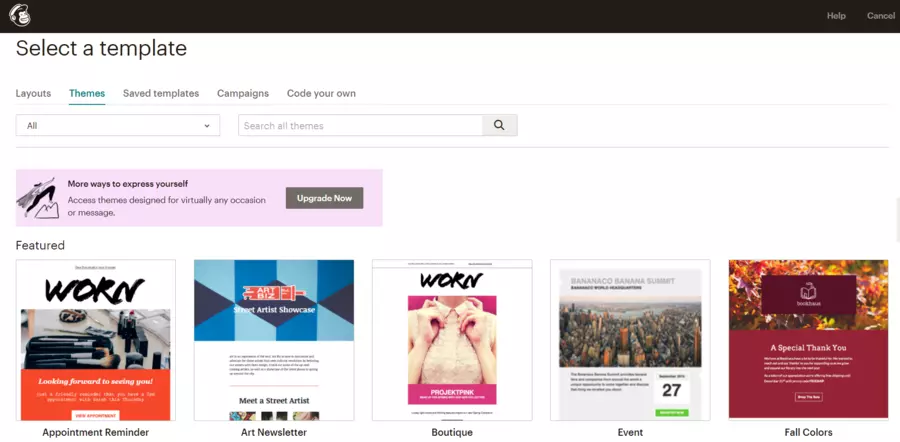
Key Take-Aways: The template concepts of ConvertKit and MailChimp are different. MailChimp is design-centric. It has around 100 templates. But ConvertKit is text-based. It has only around 5 templates. And all of them are text-based. So here we can’t determine a winner. Both of them are good in their own way.
Winner of Templates: It is a tie
ConvertKit : 2 – 1 : MailChimp
5. Email Builder
>> ConvertKit
The email builder of ConvertKit comes under the broadcast. Broadcast is a one-time email to your customers. Creating a broadcast in ConvertKit is very easy. And also the email builder is easy to use. There are only limited options present in the editor section. The email builders are text-based. So, the customization of only the text like changing font size, font color, and adding images is available.
You can create an A/B test from the editor itself. There the A/B test is for the subject line. You can create 2 subject lines and test which subject line is performing better.
ConvertKit Email editor
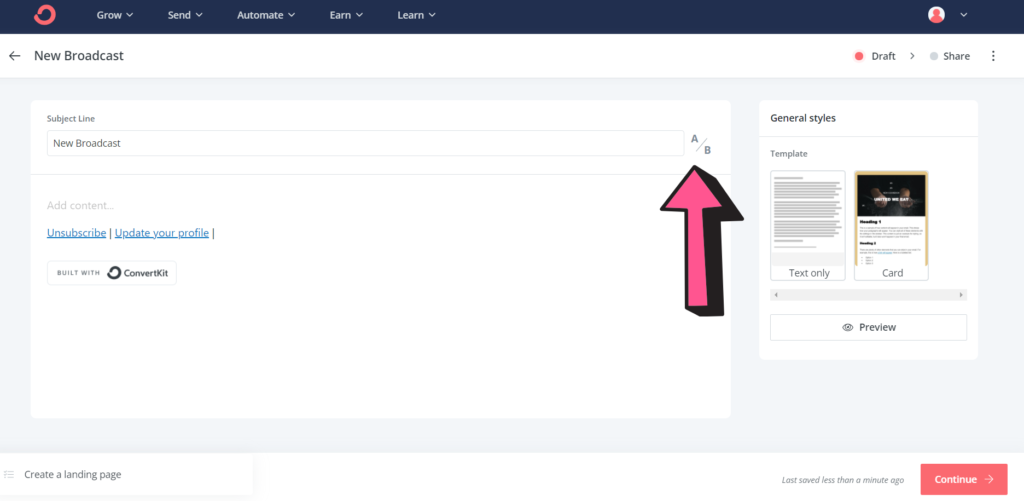
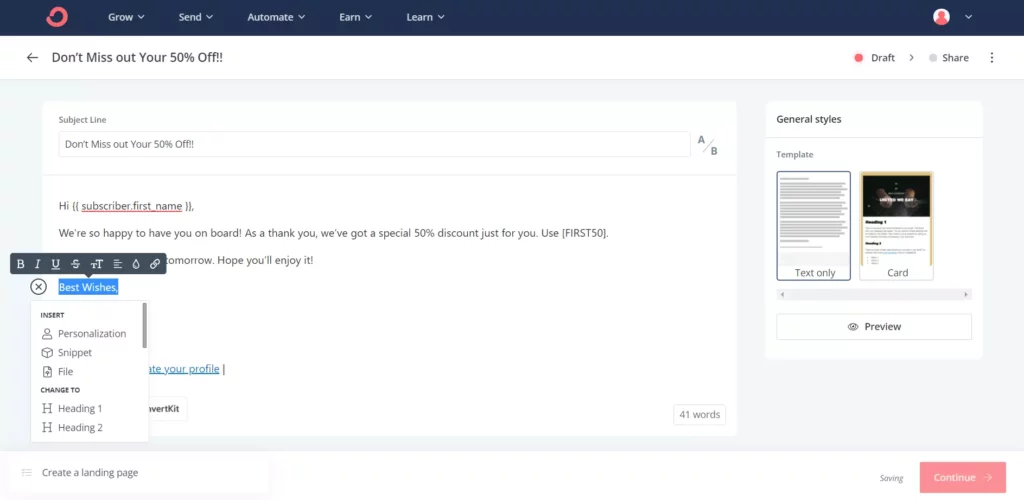
>> Mailchimp
In the case of Mailchimp, you can create Regular emails, Landing pages, and also embedded forms. You can send up to 10,000 emails per month using Mailchimp’s free plan itself. MailChimp has more features for creating campaigns than in ConvertKit email campaigns.
Mailchimp’s email editor is user-friendly and easy to navigate. All the options are present on the right side itself. You can simply drag and drop the blocks you want. You have plenty of features in the Mailchimp editor. You can also add videos. For the free version, you can have all the features in the Mailchimp email editor. But to create Dynamic content, you need to upgrade the plan to $14 /month.
Mailchimp Email editor
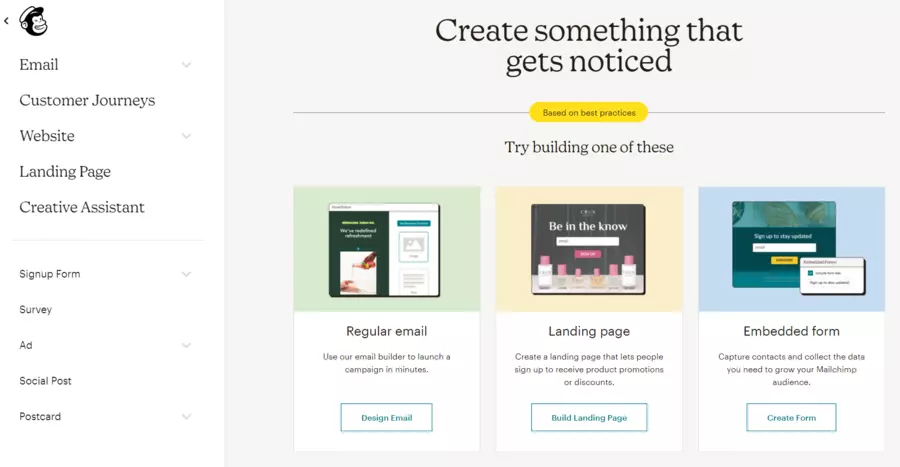
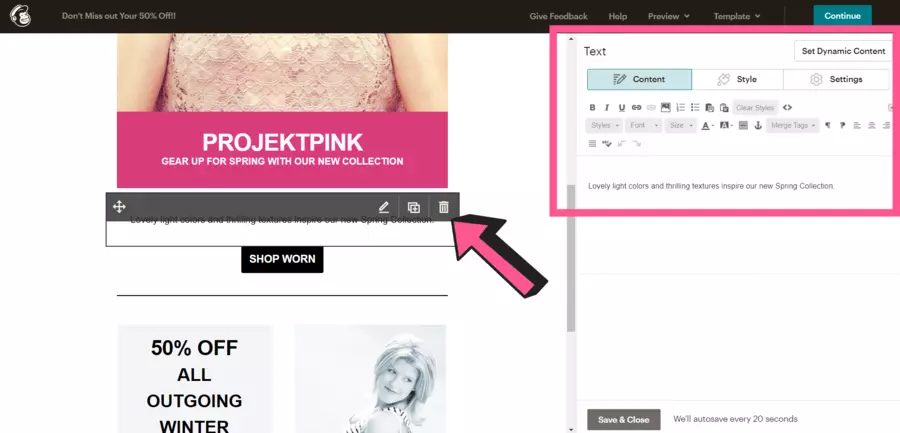
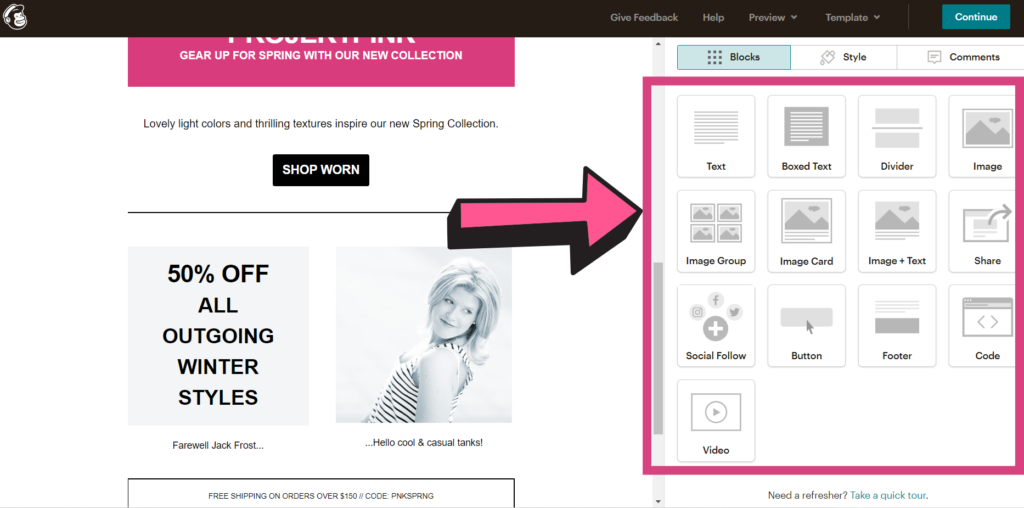
Key Take-Aways: The email builder of Mailchimp is better. Because it has so many options in the editor. You can add images, videos, etc. But ConvertKit allows you to add only images and also it allows you to change the font style.
Winner of Email Builder: MailChimp
ConvertKit : 2 – 2 : MailChimp
6. Automation Workflow
>> ConvertKit
ConvertKit also has a great visual automation workflow. You can create your own automation workflow as well as you can use templates. There are so many options are available for ConvertKit such as Event, Action, and Condition. Automation is available in the $9 and higher plan and not in the free version.
Convertkit automation
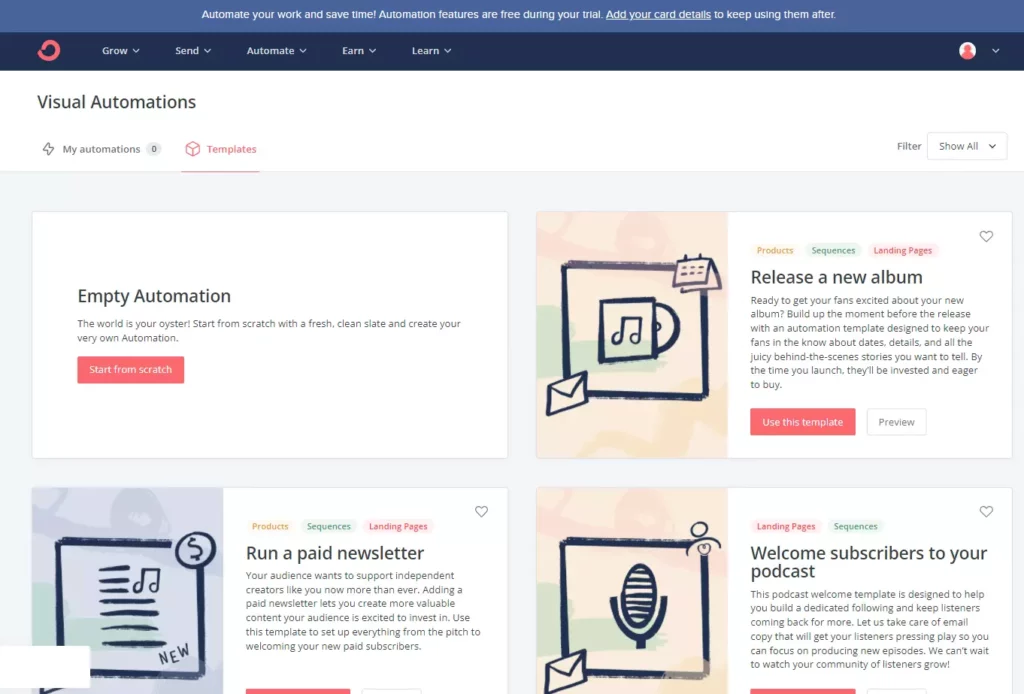
The visual automation workflow of ConvertKit is given below.
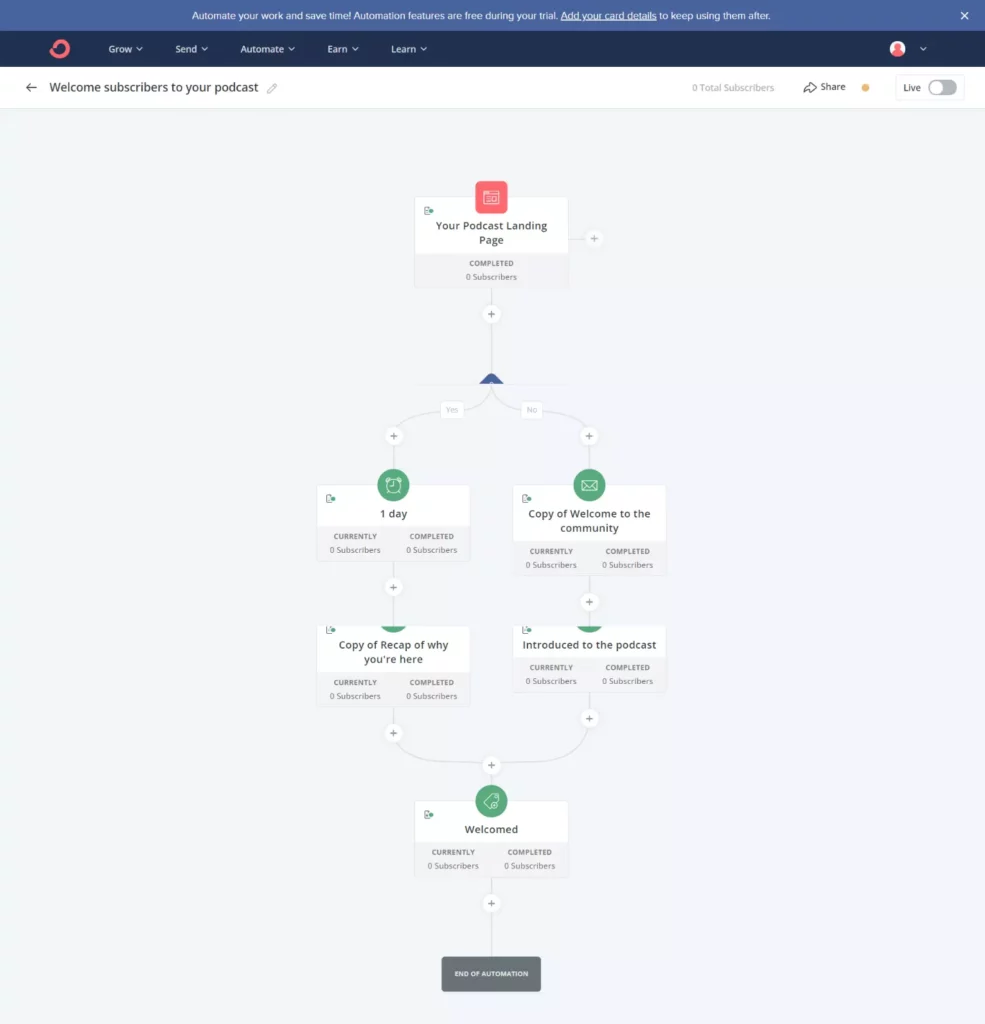
>> Mailchimp
In Mailchimp, the $9 and the higher plan includes automation workflow. You can create only 1 automation using the free plan. There are about 25 automation workflow triggers based on the various customer activity. You can also visualize the journey of the customer in a simple way. If you want advanced automation features, you need to upgrade to $9 or to other higher plans. Mailchimp has also a multi-step workflow based on customer activity. You can create complex workflows using the $14 plan.
Mailchimp Automation
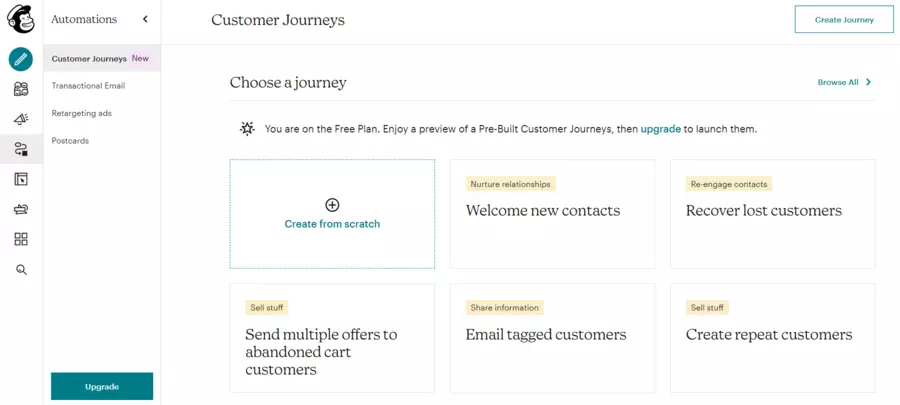
The automation workflow of MailChimp is given below.
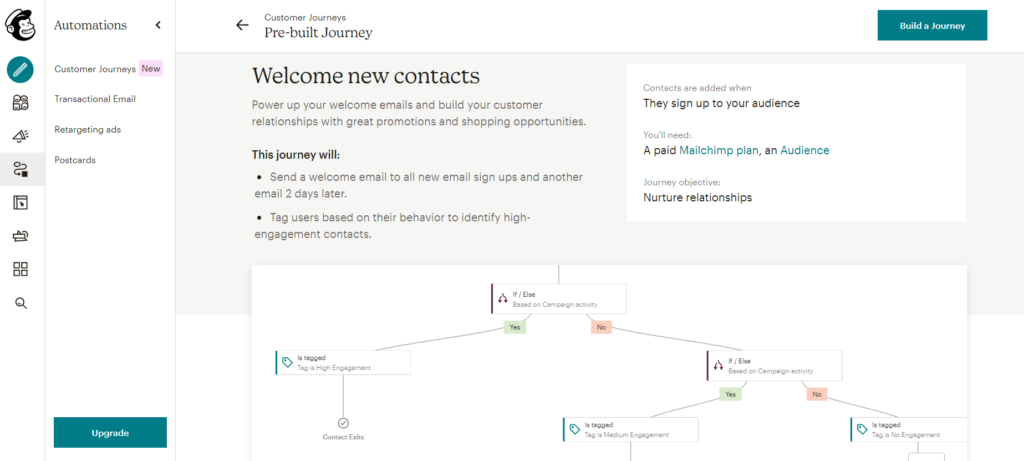
Key Take-Aways: The automation of both ConvertKit and MailChimp is good. Both of them have so many options in their automation.
Winner of Automation: It is a tie.
ConvertKit : 3 – 3 : MailChimp
7. Integration
Both ConvertKit and MailChimp provide various numbers of integration. And both of them allow you to set up APIs.
>> ConvertKit
ConvertKit has around 100 integrations. It is integrated with popular apps and websites like Shopify, Squarespace, WordPress, Zapier, Woocommerce, etc. But they are not integrated with big CRMs. The list of some integration in ConvertKit is given below.
ConvertKit Integration
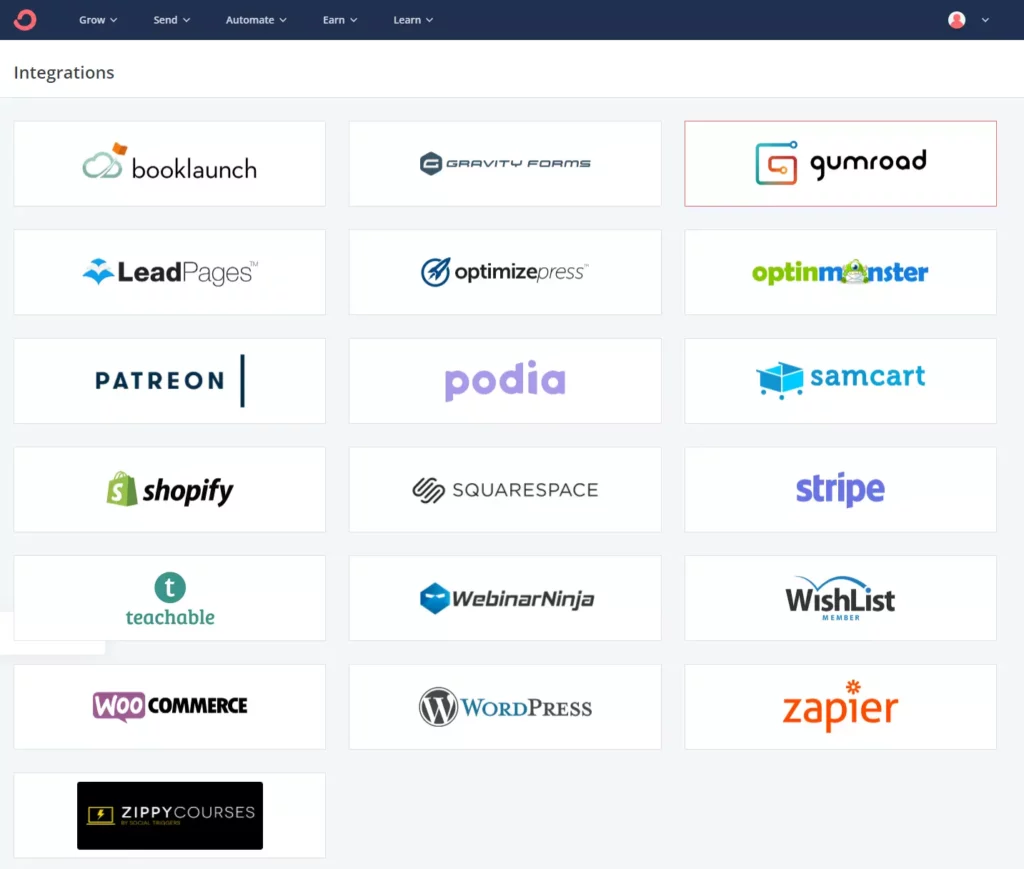
>> MailChimp
Nobody can beat MailChimp at integration. Mailchimp offers more than 250 integrations. They are also integrated with major CRMs. Their integrations are categorized into Ecommerce, productivity, point of sale, etc.
Mailchimp Integration
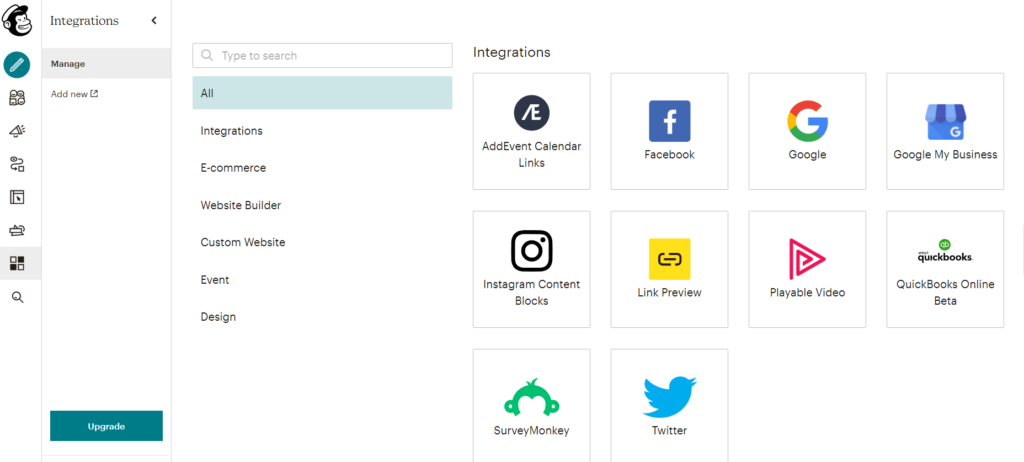
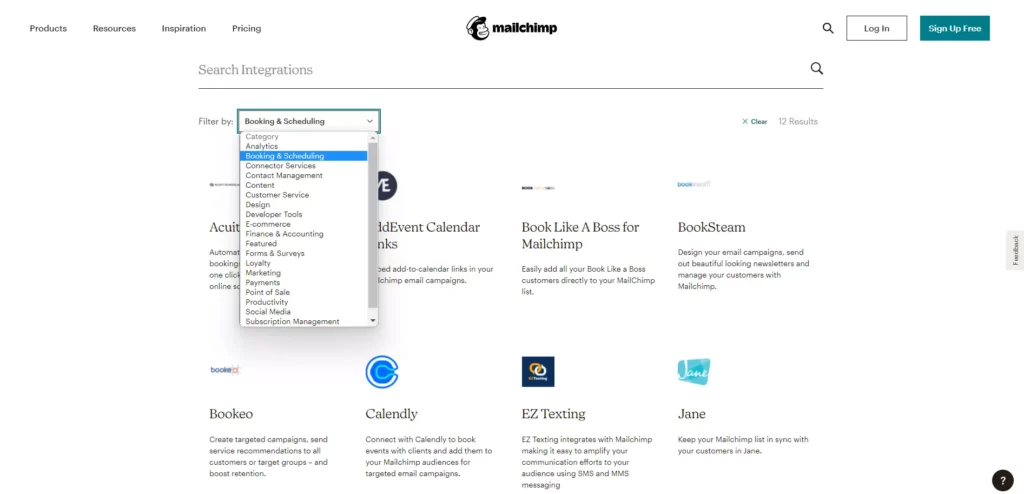
Key Take-Aways: MailChimp has around 250 integrations. But ConvertKit has only around 100 integration. Here we have a clear winner.
Winner of Integration: MailChimp
ConvertKit : 3 – 4 : MailChimp
8. Pricing Comparison
>> ConvertKit
The pricing plan of ConvertKit is given below.
Free: Up to 1000 subscribers, Unlimited landing pages & forms, Send email broadcasts, Sell digital products & Subscription, Community support
Creator: $9 /month Features of Free plan + Free migration from another tool, Automated funnels & Sequences.
Creator Pro: $25 /month Creator plan features + Facebook custom audience, Newsletter referral system, Subscriber scoring. Advanced reporting
ConvertKit Pricing

>> MailChimp
The pricing plan of MailChimp is given below.
Free: Marketing CRM, Creative assistant, Website builder, Mailchimp domain, and Forms & landing pages.
Essential: $9 /month: Email and landing page template, Customer journey builder, custom branding, A/B testing, 24/7 email, and also chat support.
Standard: $14 /month: Customer journey builder and Branching points, Send time optimization, Behavioral targeting, Custom templates, and also dynamic content.
Premium: $299 /month: This plan is for expert builders. Advanced segmentation, Multivariate testing, comparative reporting, Unlimited seats & role-based access, and phone support.
Mailchimp Pricing
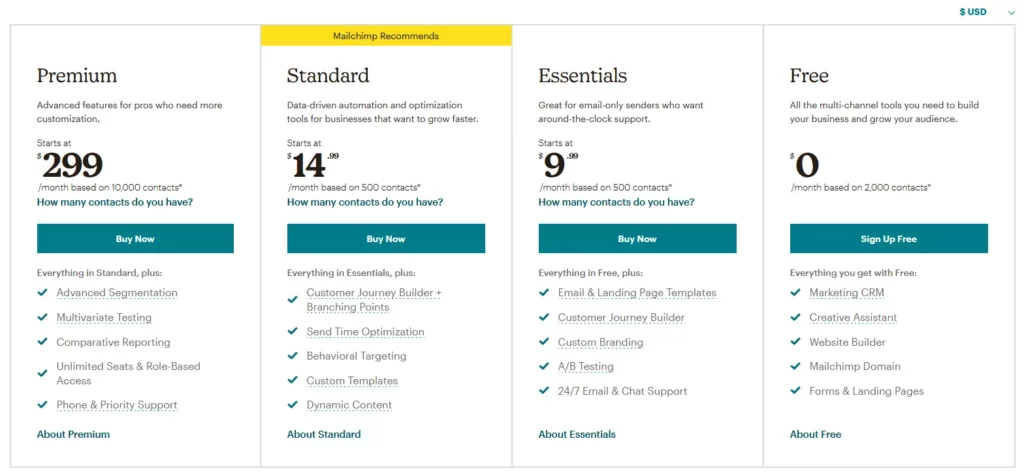
Key Take-Aways: Both MailChimp and ConvertKit provide you free plan. MailChimp allows you to send 10,000 emails and 2000 contacts. You can send 1 automation and campaign in a free plan. But ConvertKit allows you only 1000 contacts. There is no automation are possible in the free plan. And for a paid plan, the cost is a little high for the ConvertKit.
Winner of Pricing: MailChimp
ConvertKit : 3 – 5 : MailChimp
9. Customer Support
The customer support option for both ConvertKit and Mailchimp are pretty good. But when it comes to action, the customer support is not so good for both. But when compared to MailChimp, ConvertKit’s customer support is better.
>> ConvertKit
ConvertKit offers email support and Live Chat support for all the customers (For free plans and also for higher plans), and also they are providing peer-to-peer support. They are providing limited live chat support on weekends. And also they are providing free quick migration for all plans and free advanced migration for importing 5k+ contacts. But the Customer support of ConvertKit is not that good. Because they are not providing better customer support. They will take time to reply to us.
>> MailChimp
MailChimp provides customer support via Live Chat, Email, and phone support. 24/7 email and chat support is provided for the $9 plan, phone support is provided for the $299 plan. You will not get proper customer support for the free plan.
Key Take-Aways: The quality support of both ConvertKit and MailChimp is not so good. But when we compare both of them, the quality support of ConvertKit is better than MailChimp.
Winner of Quality Support: ConvertKit
ConvertKit : 4 – 5 : MailChimp
A detailed comparison of their features is given below.
| Features | ConvertKit | MailChimp |
|---|---|---|
| Found in | Started in 2013. Headquarted in Boise, Idaho | Started in 2001. Headquartered in Atlanta, US |
| Email sign up forms | ||
| Email marketing | Best for content creators like bloggers, and writers etc. | It has so many features when compared to ConvertKit. Free version is available. Mailchimp is better for experts or advanced users. |
| List Segmentation | ||
| Email Builder | MailChimp also allows you to build customized emails. It has plenty of email templates. It doesn't have saveable content blocks. Mailchimp has the product recommendation feature only for certain products. | |
| Gamification | ||
| Templates | Classic, Modern & Text only - Only 3 options. | About 100 templates. |
| Testing | A/B testing for subject line. | Multivariate Testing: It is just the evolution of AB testing that contains 8 variations instead of two variations that you get in A/B testing. It is only available for a $299 /month plan. A/B Testing |
| Contact List Management | You can add single subscribers, Import CSV file, Import from other service providers like MailChimp, Drip, Mailer lite etc. | You can upload a CSV or tab-delimited TXT file, Or you can Copy and paste contacts from a spreadsheet. |
| Pricing /Month & relatively costly or affordable for the business. | Pricing: Hover here to see Convertkit Pricing | Pricing: Hover here to see Mailchimp pricinng quick-view |
| Visual Automation Workflow | ConvertKit has a great Visual automation workflow. | MailChimp offers basic automation workflows. It will create only simple workflows for your campaign. And also there is no visual automation workflows. |
| Integration | Great number of integration and allow to set up APIs. Integrated with about 100 apps and websites like Shopify, WordPress, Zapier, Wix etc. | MailChimp is integrated with more than 250 apps and websites like ShopSync, WooCommerce, Magento etc. |
| Analytics & Report | No separate section for report. Basic reporting in the email section. | Vast analytics and report. |
| Social Marketing | ||
| Website builder | ||
| Customer Support | 24/7 Live chat Email/ Helpdesk Migration | 24/7 Live Chat Email/ Help Desk Knowledge Base FAQs/Forum Phone support - For premium plan |
| Landing page Editor | ||
| Deliverability & Open Rates | High chance of deliverability. High number of emails are delivering to subscribers inbox. | High chance of going to spam list and promotion folders. Deliverability rate is low. |
| Top Websites | The top websites that use ConvertKit is given below. >> Blogging For Devs >> RecipeTin Eats >> Sally's Baking Addiction >> Natasha's Kitchen >> Once Upon a Chef | The top websites that use MailChimp are given below. >> Go.com >> Discogs >> Jopwell >> Unsplash >> Blic Online |
In my opinion, the most important factor in selecting an email marketing platform is the platform’s ability to collect subscribers’ emails. The second most important thing is the platform’s ability to deliver emails to subscribers’ inboxes. Both ConvertKit and MailChimp are great email marketing tools. Both of them have distinct features.
Alternatives of ConvertKit & MailChimp
- >> MailerLite
- >> Constant Contact
- >> AWeber
- >> Moosend
- >> Campaign Monitor
- >> SendPulse
- >> Pardot
- >> Sendinblue
- >> GetResponse
- >> ActiveCampaign
Note
MailChimp has more features than ConvertKit. MailChimp is a design-based email marketing tool. And ConvertKit is a Text-based email marketing tool. But the studies are saying that the deliverability of emails is high for text-based emails. ConvertKit is easy to use and easy to navigate. Because only limited and essential options are provided by ConvertKit. MailChimp on the other hand is a little bit confusing. They have so many options to navigate. The integration is higher for MailChimp when compared to ConvertKit. But when it comes to automation, ConvertKit offers you a visual automated workflow.
Conclusion
Choose ConvertKit
- If you have a creative business
- If you are not focusing on Template-based campaigns
- If you want more support
- If you want a visual automation workflow
- If you need only one subscriber’s list
Choose MailChimp
- If you want more integrations
- If you need a design-based email marketing tool.
- If you need more options in email builder.
- If you wnat more featues.
- If you have a low budget
Choosing between MailChimp and ConvertKit is a little bit difficult. If you need a design-based email marketing tool, you can opt for MailChimp. If you need a simple text-based email marketing tool, you can opt for ConvertKit. If you need only one email list with different segmentation, then you can opt for ConvertKit. Otherwise, you can opt for MailChimp. If you need better customer support, opt for ConvertKit. Both of them are the best email marketing tool. You can try them both for free.
Top News of ConvertKit & MailChimp
- Want to Prove Patience Pays Off? Ask the Founders of This 17-Year-Old, $525 Million Email Empire
- Intuit’s $12B Mailchimp Purchase Breathes New Life Into Email Marketing
- Mailchimp Debuts Resource For Entrepreneurs Of Color
- “Playful” Mailchimp redesign aims to unify brand while encouraging creativity
- ConvertKit acquires FanBridge, doubling down on expansion into the music industry
Top Commercials
MailChimp
ConvertKit

Sophia Gilbert is an Email Marketing Specialist and Web Application Expert with 10+ years of experience. She meticulously tested and used most of the email marketing tools & website builders in the real field. Here she is sharing reviews and comparisons of different email marketing tools based on her past experience through different companies where she has worked.



